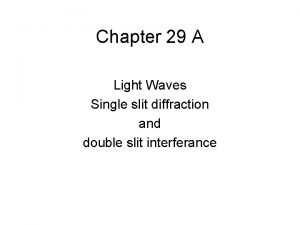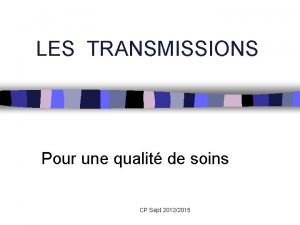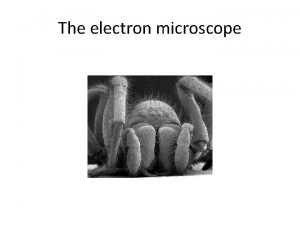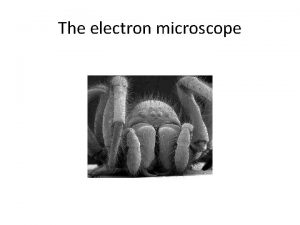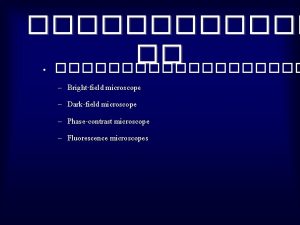Electron Diffraction ED in the transmissions electron microscope








- Slides: 8

Electron Diffraction (ED) in the transmissions electron microscope A. E. Gunnæs MENA 3100 V 08

JEOL 2010 F in the Research park A. E. Gunnæs MENA 3100 V 08

Basic TEM Electron source (HV= 200 k. V) Apertures Magnetic lenses Sample holder Vacuum in the column better than 10 -6 Pa Fluorescence screen Film box Pedals for tilting the sample A. E. Gunnæs MENA 3100 V 08

The lenses and apertures in a TEM ΔU= ~100 -1000 k. V Filament λ= h/(2 me. V)0. 5 (NB non rel. Expr) Electron source: Anode ●Tungsten, W 1. and 2. condenser lenses Condenser aperture ● La. B 6 ● FEG Sample Objective lens Objective aperture Recording media: Selected area aperture (diffraction aperture) Intermediate lenses ●Film ● Imaging plates ● CCD camera Projector lens Image A. E. Gunnæs Fluorescence Screen (Zn. S or Zn. S/Cd. S powder) MENA 3100 V 08 ●TV camera

Simplified ray diagram Parallel incoming electron beam 3, 8 Å Si Sample Convergent beam -Discs in diffraction -Micro diffraction -STEM mode -Chemical analysis 1, 1 nm Objective lense Diffraction plane (back focal plane) Image plane A. E. Gunnæs MENA 3100 V 08

Electron diffraction Inelastic scattered electrons Elastic scattered electrons Direction and magnitude of v change. Only the direction of v is changing. (Bragg scattering) Elastic scattering is due to Coulomb interaction between the incident electrons and the electric charge of the electron clouds and the nucleus. (Rutherford scattering). The elastic scattering is due to the average position of the atoms in the lattice. Energy is transferred to electrons and atoms in the sample. -It is due to the movements of the atoms around their average position in the lattice. - It give rise to a diffuse background in the diffraction patterns. Reflections satisfying Braggs law: 2 dsinθ=nλ Electrons interacts 100 -1000 times stronger with matter than X-rays -more absorption (need thin samples) -can detect weak reflections not observed with x-rays A. E. Gunnæs MENA 3100 V 08

Sample preparation TEM grids 3 mm A. E. Gunnæs MENA 3100 V 08

Sample holders Sample positions Cooling Standard Heating A. E. Gunnæs MENA 3100 V 08

